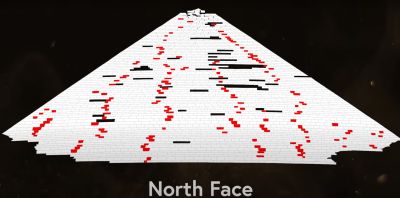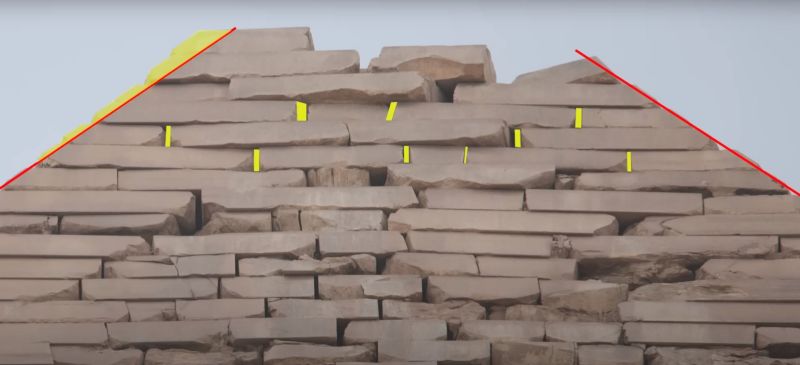As one of the most famous Ancient Egyptian pyramids, the Pyramid of Khafre on the plateau of Giza has been a true wonder of the Ancient World ever since its construction around 2570 BCE. Today, well over 4,500 years later, we are still as puzzled as our ancestors over the past hundreds of years how exactly this and other pyramids were constructed. Although many theories exist, including ramps that envelop the entire pyramid, to intricate construction methods from the inside out, the only evidence we have left are these pyramids themselves.
This is where the jokingly called [History for Granite] channel on YouTube has now pitched some new ideas, involving the casing stones that used to fully cover the Pyramid of Khafre, prior to widespread theft and vandalism.

Despite the pyramids of Giza in particular being a veritable tourist trap, said tourists are heavily discouraged from climbing onto the pyramids, or even set up high-powered camera gear on tripods near them. Even with drone footage available, it was necessary to get a zoomed-in look on the casing stones that remain on the pyramid of Khafre near its top at well over 100 meters. Working within these limitations, it was possible to take detailed photos of three sides of the pyramid, which revealed interesting details.
In the top screenshot from the video the top of the pyramid is visible, which gives some indication of just how much the pyramid may have shifted out of alignment due to earthquakes over the millennia. This turned out to be not significant enough to account for some purported ‘gaps’ between the casing stones, with supposed ‘filler material’ from scaffolding holes explainable as just broken off sections of these casing stones. What was more interesting was that a pattern could be found in so-called bonding stones.

These bonding stones have a slanted end, so that they can be lifted slightly above a matching slanted stone, before being lowered to complete a row of bricks or stonework. After analyzing the three faces of the still mostly intact casing stones, a clear pattern emerged, such as that on the north face, pictured here.
What this suggests is that each row of casing stones were laid down by multiple groups of workers, each starting at a specific point before coming together where those sections would be joined with a bonding stone. This lends credence to the theory that the pyramid was constructed layer by layer, including the outer covering. To further examine these clues, the even older Bent Pyramid at the royal necropolis of Dahshur with mostly intact casing stones will be examined in more detail next.
If anything this series shows just how much there still is that we don’t know about these massive construction projects that are really only preceded by the works of the Sumerian and Akkadian people.

















My bet would be that the limestone covering was carefully made to fit the underlying “rough bricks” and after that the rough hewn outer shape was cleaned up after the pyramid was totally covered.
So it was a two step process. Cover it with limestone, then chip off later what is not needed.
I know that “build the core then add the casing” is the classically accepted story, but based on my admittedly limited masonry experience working construction during my summers college, this never really made any sense to me.
These aren’t small bricks. The casing stones were *big* and fitting them so that they mated well on the hidden back and undersides would be really hard. Imagine fit-cut-test-repeat with a 5 ton rock on the side of a cliff. Now do it a couple of thousand times.
And it would be a total pain getting those stones *up there* in the first place, since you’d have to schlep them up the slick, finished surface below you as you built.
I think it’s much more likely that the casing was built in layers, along with the rest of the pyramid as it rose.
It would be way easier that way. Start a new layer, do an outside ring of casing stones, do the inner features, then fill in the rest of the layer like you’re tiling a giant patio. Repeat as necessary.
Think of it as the multi-filiment 3D printer approach. But, you know, bigger.
You might have to clean up the outside shell as the building settles, but that’s a step you’d still need if you saved the casing for last.
The Great Pyramid has a rubble filled ramp spiraling around just beneath the outside. Its existence was discovered by cosmic ray detection experiments then much later confirmed by climbing up to ‘the notch’ near the top on one of the edges. Just inside the notch is a room with rubble filled tunnels leading off from it. The corner rooms would have been where the stones were turned to go up the next ramp section.
Once the pyramid was topped out, workers would have backfilled the spiral tunnel with rubble from the top down. Most likely the outer casing stones were applied simultaneously with the leveling up of the core. Moving the casing stones up the same tunnel would make the most sense.
What would be very interesting is to locate and open up the bottom end of the tunnel, then clearing some of the rubble out for tourist access. Would only need to empty out 10 to 20 feet so people can see how it was constructed then filled.
Pyramids are not tourist traps, these are tombs.
They were simply not built with the aim of attracting tourists.
Most of people that go there or visit the inside have nothing to do there.
I once heard a group on individuals inside the king’s chamber saying “it’s not interesting, nothing to see here”. What did they expect ? A Disneyland attraction ? A fast-food ?
Btw I also climbed to the top of the Cheops pyramid, this was one of the greatest experience in my life.
Going up is ok (I’m used to rock climbing) and the steps go smaller to the top, but the descent is very dangerous mainly because of the rubble but also because of the very regular, steep slope. I went late in the afternoon when there are few people around. When back on the ground, after a short walk I met a local guy who told me that he was one of the guardians of the site and if I was interested ($$$) he could take me to the top because he knew the way…
They were built way before the Egyptian government and there is also data that shows that the pyramids could be way older than what they’re stated to be.
Can’t decide if trolling or not. At least add a build year to your story so I can decide more easily!
They were built by the Egyptian government. Just not the current one.
Well they where tombs but build mostly to project power. Also they where a lot of worshiping going on around the Pyramids more like a modern amusement park than am grave yard.
The where in practice tourist traps to attract pilgrims for the multitude of temples in the area.
There is still no evidence they were actually used as tombs.
– Pyramid (which is not the real name anyway) are not tombs.
– The papyrus describing how the Great “pyramid” has been built has been discovered in 2013 so why all those guesses ?
I’ve read an hypotese that they were power plants. And that the ark of convenant was a kind of regulator, stolen from inside the pyramid by the jews while fleeing Egypt. While it sounds crazy, the arc is a way to talk to god and vice-versa, so it may be true.
There’s a lot of theories. One of them says an egyptian pyramid was used as a water ram, because the internal passages can work as such when a scale model is built and tested with a flow of water. I’ve heard that there are salt deposits covering the internal walls of one, which is hard to explain.
There is another magical theory that states the pyramids were constructed as a healing device, and this seems to correlate to the anomalous voltages that are detected within. I’ve asked what meters were being used, because digital multimeters can be triggered by any rf source, such as a vhf walkie talkie and got no response.
Another theory states that some south american pyramids were constructed to concentrate energy to mutate seeds. This would explain the origin of maize, which was originally similar to a grass seed and it is accepted that it took thousands of years of selective breeding to make it the staple food it is today.
Bro. You can’t even write.
Thanks for linking to a version of Wikipedia with better formatting, that doesn’t treat a desktop computer screen like it’s a mobile phone.
It was the Goa’uld as a landing site for their ships.
(No, Stargate is fiction, but I am surprised no one mentioned it)
That’s as good an answer as some of the stuff people say. Yikes!
This escalated quickly.
I think at this point saying we don’t know how the pyramids were built makes as much sense as saying we don’t understand how the human brain works.
In both cases we have really good ideas about how it works. Sure, there are surprises along the way sometimes and we don’t have every singe answer but we definitely know the entire broad strokes and have many of the finer details worked out too. Not all, of course, but most.
Perhaps both are a case of that last 5% or so of knowledge being absolutely crucial to understanding and also ten times as difficult to achieve as the previous 95% combined. Many such cases.
We do not have a “good idea” how the human brain works, by the way.
Hell, the mechanism behind the most basic antidepressants has been debunked since the nineties over and over again but we still prescribe them because they still work for some reason.
Bit antidepressants don’t work. They just amplify underlying conditions which more often than not makes thngs worse.
Tourist trap, well nayve. But believe me when I tell you that the Great Pyramid is the most spectacular sight I have ever laid my eyes on. James Walsh Santa Monica Ca
What happen to Eggo waffles? Is anybody else having trouble finding them at the local market?